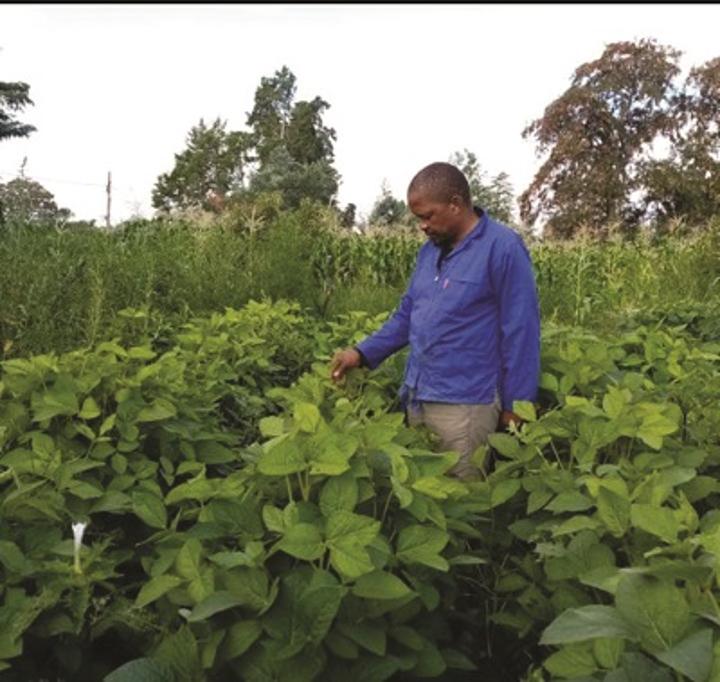Africa-Press – Lesotho. The recent extreme weather events which include heavy rains and strong winds have caused a great harm on crops, fruits, land degradation, infrastructure and food insecurity.
In an interview with Informative Newspaper, a farmer, Reverend Motipi Ranthimo said that his crops which includes potatoes, red cabbage and maize were affected by heavy rains, though not very much.
He stated that the reason in which the crops are affected by heavy rains is because even though they need moisture as an essential factor to grow; there should not be much of it in order to give the
soil and crops a chance to breathe. Rev. Ranthimo further indicated that the fruit trees which bear peaches in October, November and December were badly affected to a point where
the fruits even fell off from the trees. He had observed that the peach trees are extremely susceptible to soil flooding as a result, they drop the fruits to
try to survive as they cannot tolerate to be without oxygen due to flooding. A Climate Change Ambassador Letsatsi Lekhooa defined extreme weather events as weather conditions that are below and above normal.
With an example of heavy prolonged rains, too much sunlight, strong winds and above normal snowfalls. Lekhooa also disclosed that these extreme weather events which affect
crop production exacerbate Gender-Based Violence (GBV) as they disrupt food availability, reduce access to food and affect food quality thus leading families into violence when there is no provision of food on the table, which
in most cases is expected to be done by women. He emphasized, “Land degradation is another challenge brought about by heavy rainfalls. During floods, when rains batter the earth’s surface where
it has been degraded, most of the water flows into the water bodies and becomes surface run-off. This in turn leads to low retention of moisture in the soil
which leads to droughts. ” Lekhooa opined that in order to reduce vulnerability from the extreme weather events, he recommends the intervention of the government and
communities to have and profile climate change experts as well as other stakeholders and implement a National Disaster Recovery Committee, a team that
will be dealing with recoveries from climatic disasters. Conservation Agriculture Expert Bereng Mokete mentioned that during the heavy rains soil does not become workable and its structure can be seriously
destroyed by compaction. In addition, he indicated that majority of farm tools are not muddy-user-friendly. Mokete further pointed out that the heavy rains impact crops on weeds
competition as majority of the weed species tolerate heavy rains hence grow faster while the crops’ growth is retarded by the heavy rains and weeds out-compete them.
“Plants need air, moisture and nutrients to survive which all are found in the soil pores. Too much rain closes the soil pores hence no air circulation as a results, roots don’t grow,” Mokete highlighted.
According to a New International Study (2021) called Global climate change impacts on crops expected within 10 years that included researchers from International Institute for Applied Systems Analysis (IIASA), National
Aeronautics and Space Administration (NASA) and the Potsdam Institute for Climate Impact Research (PIK): climate change may affect the production of maize and wheat by 2030 if current trends continue.
Maize crop yields are projected to decline by 24%, while wheat could potentially see growth of about 17%. Using advanced climate and agricultural models, scientists found
that the change in yields is due to projected increment in temperature, shifts in rainfall patterns, and elevated surface carbon dioxide concentrations from
human-caused greenhouse gas emissions. These changes would make it more difficult to grow maize in the tropics, but could expand wheat’s growing range.
Furthermore, the Report of Climate Risk Country Profile on the Climate Related Hazards by the World Bank Group, Lesotho has a high degree of risk to natural hazards, including floods, drought, frost, strong winds, and
heavy snowfall. Drought is a recurring hazard which results in disasters for communities and the wider economy. Key impacted sectors include agriculture and
livestock, water, tourism, and health. Impacts of extreme rainfall events on public and private infrastructure has resulted in costly repairs, road closures, limited or no access to electricity, and complete failures of sewage
and storm water systems. Temperature proliferation are affecting infrastructure sensitive to temperature extremes, such as roads. Rainfall and temperature changes are
impacting agriculture and food security and extreme weather events are affecting tourism and livelihoods that depend on the sector and have caused human and livestock deaths, property damage, and loss of crops.
Natural hazards are exacerbated in many mountainous areas of Lesotho and the country is particularly vulnerable as more than 70% of the population live in remote and
ecologically fragile mountainous terrain. The country is also severely impacted by drought. While drought conditions are generally a common phenomenon of the
climate in southern Africa, Lesotho has experienced increasingly frequent occurrences of drought in recent years. The country’s worst dry spells were experienced in 2002/3, when
760,000 people were affected, as well as in 2006/7 when rainfall levels for the
critical months of January to March in which 45% of the expected precipitation. For the months of December 2010 and January 2011, Lesotho saw unprecedented
rains, floods and rock slides that destroyed crops, livestock and property. These events resulted in significant impact upon key economic sectors including
agriculture, transport, health, and education, with total losses and damages estimated at 3.2% of the GDP. Heaviest damages were sustained by the roads sector, livestock, education,
and housing. Heaviest losses in production were sustained by crops, road transport, and commerce sectors. Extreme rainfall has resulted in soil erosion,
land degradation, loss of ecosystems and ecosystem services, alien species invasion, salinization of groundwater, and flood trails containing pesticides
and fertilizer. More than 90% of disasters in Lesotho are related to climate variability and change, specifically, drought, snowfall, hailstorms, strong
wind, localized floods, early frost and pest infestations. Recent hailstorms, heavy rains, and flash floods in Lesotho have resulted in significant damage to houses, vehicles, roads, schools, and health centers as well as key crops, maize, beans, and sorghum.
For More News And Analysis About Lesotho Follow Africa-Press






